 |
|
|
|
|
|
|
|
 |
 |
 |
 |
|
|
 |
 |
 |
|
|
|
|
|
|
|
|
|
|
|
|
|
|
|
|
|
|
|
|
|
|
|
|
|
|
|
|
|
|
|
|
|
|
 |
 |
 |
Posted: |
Aug 13, 2017 - 3:44 PM
|
|
|
|
By: |
Bob DiMucci
(Member)
|
The inspiration for GOJIRA, which is a name combining the Japanese words for gorilla and whale, was an incident that occurred in March 1954 near the Bikini Atoll in which a Japanese vessel carrying a crew gravely ill from radiation poisoning drifted into the area, which was used at the time by the United States as a nuclear testing site. Japanese producer Tomoyuki Tanaka used the incident's relevance to Cold War nuclear fears and the actual 1945 bombings of Hiroshima and Nagasaki as a springboard for the story. The original GOJIRA was the highest budgeted film made in Japan to that time, and the simultaneous production of GOJIRA and THE SEVEN SAMURAI almost bankrupted Toho Studios.
Stop motion animation in the style of KING KONG (1933) was rejected for GOJIRA because of the time it would take and the subsequent cost. Also, according to special effects director, Eiji Tsuburaya, there was simply no one in Japan who was skilled and experienced in doing that kind of stop motion animation. The figure of Godzilla was sometimes a model and sometimes Haruo Nakajima in a rubber suit (although two other actors also wore the suit at various points in the production). Ishirô Honda directed the film. Akira Ifukube’s score received its first release on a Toho Records LP in 1967.
GOJIRA opened in Japan on 3 November 1954. Jewell Enterprises, Inc. partners Richard Kay and Harold Ross purchased a print of GOJIRA and brought it to the United States. In early 1956, Edward Barison, president of Cinema Distributors of America, and Boston-based distributor Joseph A. Levine finalized an agreement to form a new international production and distribution corporation, TransWorld Releasing Corporation. They decided that the first venture of the new company was to be distributing GODZILLA, KING OF THE MONSTERS, to which they had acquired the rights from Kay and Ross. The name “Godzilla” was actually the idea of Toho and its international sales division. "Godzilla" or "Go-dzi-la" is the proper pronunciation of "Gojira" in its native Japanese, and GOJIRA was described by Toho as "Godzilla" in their 1955 English language sales catalogue, a full year before finding an American distributor. The film even played briefly in Japanese-American owned theaters in Los Angeles and New York that year under the title of "Godzilla," before the Americanized version was released. Toho has since been the sole owners of the name “Godzilla.”
With Kay and Ross acting as executive producers, the distributors decided to Americanize the film before releasing it in the U.S. Additional footage for GODZILLA was shot in the United States, with American Terry Morse directing the new footage and editing it into the original Japanese film. The American scenes were shot on a small, rented sound stage on La Brea Avenue in Los Angeles and cost approximately $100,000 to produce. While the American release ran 80-81 minutes, the Japanese original ran approximately 96 minutes. All of the footage featuring Raymond Burr as "Steve Martin" was added to the Japanese footage. However, Burr was not the only American actor in the cast; Japanese-American actor Frank Iwanaga, who portrayed "Tomo Iwanaga," was also in the added scenes, as were several Asian-American bit players and extras. The film's opening sequence, as well as a number of scenes within the long flashback, combine original Japanese footage with interpolated shots or scenes of Burr, Iwanaga, and other American-based actors either observing what is happening or reacting to it.
For example, in one sequence set on Odo Island, when the Japanese cast is seen running up and down the hillside, shots are interpolated of Burr and Iwanaga on a similar terrain, as if in the same sequence. Other scenes were made to appear as if Burr was in the same shot with some of the Japanese actors by use of stand-ins, photographed from behind, who physically resembled and wore the same clothing as the Japanese actors. There are no subtitles in the American version, and very little of the dialogue was dubbed into English. Most of the Japanese dialogue is either unnecessary to the understanding of the unfolding action, is related in Steve's running narration, or is translated into English by Iwanaga to Burr.
Al C. Ward, who later wrote the entire 171-episode run of "Medical Center," was given a choice of $2,500 up front to write the American scenes for GODZILLA or five percent of the profits. Ward, thinking the movie would bomb, took the cash. He later admitted to telling students of his college movie writing classes that he always regretted the decision. It was estimated he could have raked in $5 million in his lifetime from residuals.
GODZILLA, KING OF THE MONSTERS opened in New York on 27 April 1956. In May 2004, New York City-based Rialto Pictures, which had acquired the rights to GODZILLA, KING OF THE MONSTERS, released the original, uncut Japanese GOJIRA, in celebration of the fiftieth anniversary of its release.
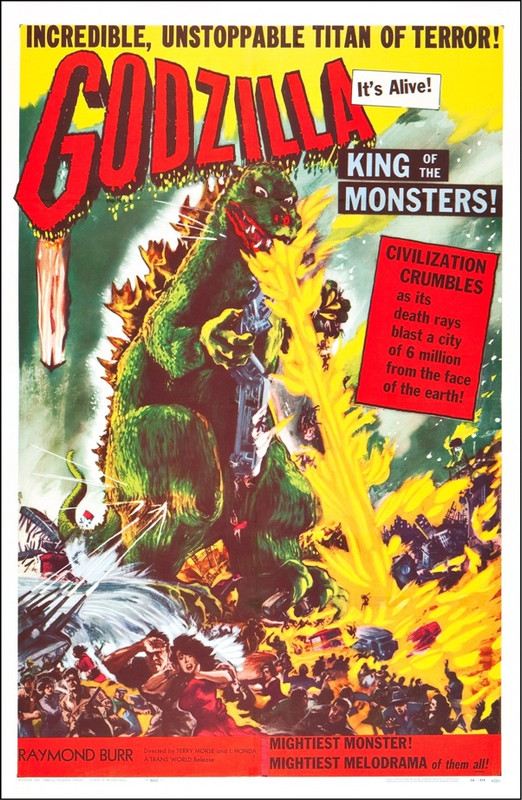
 |
|
|
|
|
|
 |
 |
 |
Posted: |
Aug 13, 2017 - 7:58 PM
|
|
|
|
By: |
Bob DiMucci
(Member)
|
Godzilla became such a huge hit that Toho produced a sequel and got it into theaters, despite the numerous special effects scenes required, in less than six months after the original film was released. Godzilla returned in 1955's GODZILLA RAIDS AGAIN. In this film, Godzilla battles an irradiated Ankylosaur and destroys Osaka in the process. Motoyoshi Oda directed the film, which was scored by Masaru Satô.
The Godzilla suit used in this movie was very similar to the first one. It was slimmed down to fit Haruo Nakajima better and to make the acting process a little more comfortable. It also allowed him to make more violent moves while shooting battle scenes. In addition, the irises were much bigger than the original suit, which had smaller eyes, and had the "beady" look. The dorsal fins were kept about the same size and shape as the original, there were still four toes on each foot, and the little ears were still behind his eyes.

In 1959, Los Angeles entertainment attorney Paul Schreibman acquired the film for U.S. distribution, dubbed it into English, replaced the score with music that Paul Sawtell and Bert Shefter had written for KRONOS (1956) and THE DEERSLAYER (1957), and renamed it GIGANTIS THE FIRE MONSTER. There have been two different stories as to why Godzilla's name was changed to "Gigantis" in the American version:
Schreibman could not get permission to use "Godzilla" from Joseph E. Levine, who had the American rights to the name. Thus he had to change the name to "Gigantis".
In an interview, Schreibman said that he changed Godzilla's name to "Gigantis" to give the audience the impression that they were seeing a new monster. He has since regretted that decision.
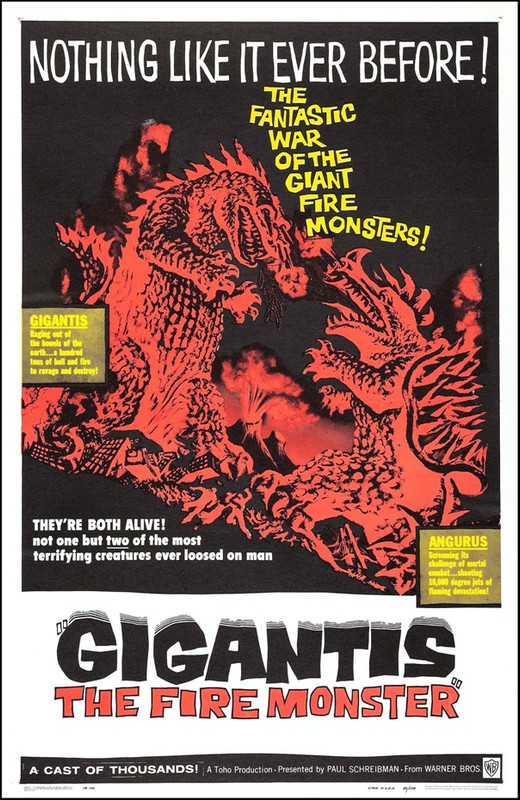
Paul Schreibman also had the rights to the ultra low budget TEENAGERS FROM OUTER SPACE. He was able to negotiate a deal with Warner Bros.to release the pair as a pre-packaged double feature.

 |
|
|
|
|
|
 |
 |
 |
Posted: |
Aug 13, 2017 - 8:58 PM
|
|
|
|
By: |
Bob DiMucci
(Member)
|
As with Godzilla, writer Ken Kuronuma turned to prehistoric animals for inspiration in developing the character RODAN, though unlike the former, whose species is largely left ambiguous, Rodan is explicitly stated to be a kind of Pteranodon. Just as Godzilla was conceived as a symbol of an American nuclear threat, Rodan was seen as an embodiment of the same danger originating from the Soviet Union.
The actual name of the monster in Japan was "Radon." However, because radon was the English name for a chemical element, when dubbed for the U.S. market the name was changed to "Rodan"
Rodan was portrayed via a combination of "suitmation" and wire-operated puppets for flight sequences. During suitmation sequences, Rodan was portrayed by Haruo Nakajima. During one scene, the cable holding the 150 lb. suit above a water tank snapped, causing Nakajima to fall 25 feet into the water, and come close to drowning. The incident was left in the movie as the scene where Rodan dives into the water near a bridge and submerges. The cables were reattached for the scene where Rodan lifts off out of the water, but they almost broke again because the suit became waterlogged and doubled in weight.
Ishirô Honda directed the film, which was scored by Akira Ifukube. RODAN premiered in Japan on 26 December 1956. A U.S. release by RKO Radio Pictures was planned soon thereafter. The film was dubbed into English, re-edited, and advertising was prepared.
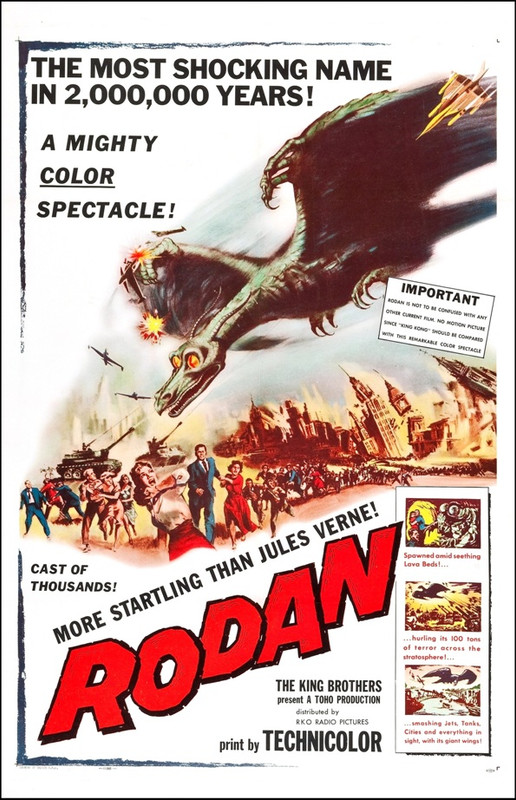
However, in early 1957, RKO, which had been struggling financially for years, decided to get out of the motion picture production and distribution business. Film properties to which RKO held distribution rights were offered to other companies, and Distribution Corporation of America (DCA) acquired the rights to RODAN, which it released on 6 August 1957. The film became one of the biggest successes for the small U.S. distributor. Later, material sent to exhibitors for other DCA releases would carry the slogan "From the company that brought you 'RODAN'."
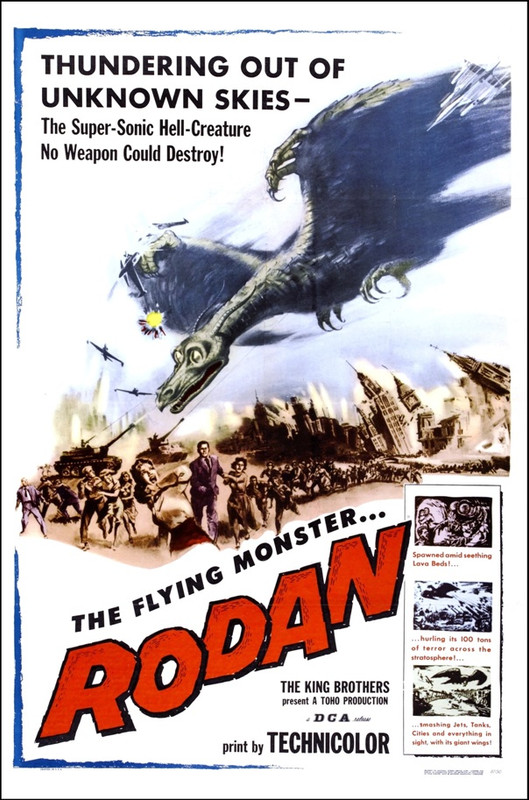
 |
|
|
|
|
|
 |
 |
 |
Posted: |
Aug 13, 2017 - 11:17 PM
|
|
|
|
By: |
Bob DiMucci
(Member)
|
THE MYSTERIANS are aliens who arrive on Earth and ask permission to be given a certain tract of land for their people to live on. But when they are discovered to be invaders, responsible for a giant robot that is destroying cities, the armed forces attempt to stop them with every weapon available. Haruo Nakajima appeared as the robot, "Mogera," (alternately, "Moguero"). The name Mogera was based on the Japanese word for mole ("mogura"). The robot, which was not in the original script, was added at the insistence of producer Tomoyuki Tanaka, who felt the movie needed a giant monster.
Ishirô Honda directed the film, which had a score by Akira Ifukube. The film was released in Japan on 27 December 1957. RKO Radio Pictures had acquired U.S. distribution rights, dubbed the film into English, and prepared advertising prior to going out of the distribution business.
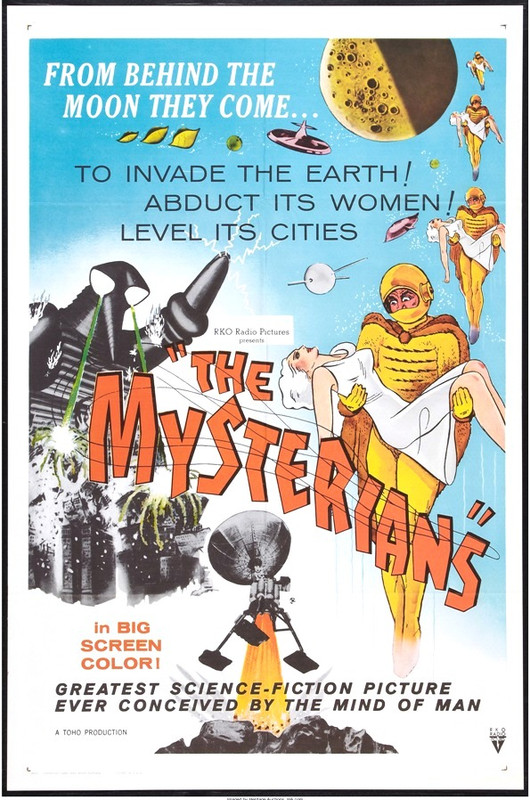
RKO sold off distribution rights to Metro-Goldwyn-Mayer, who released the film in May 1959 as part of various double bills with such films as WATUSI and FIRST MAN INTO SPACE.
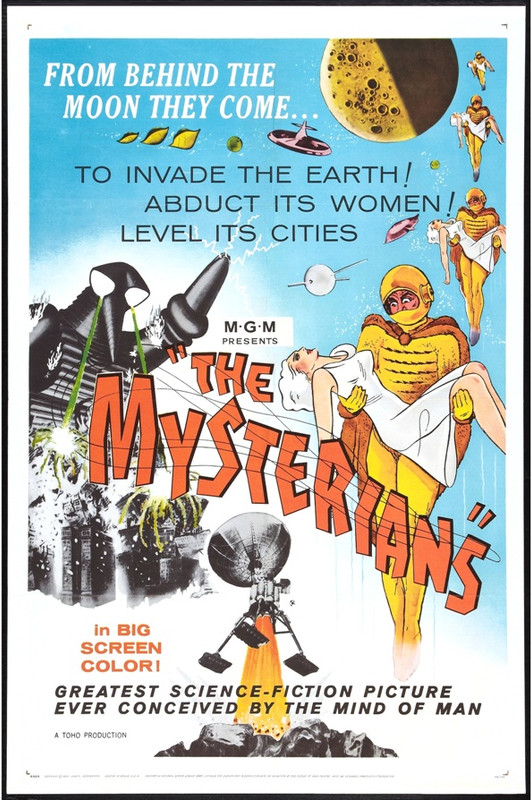
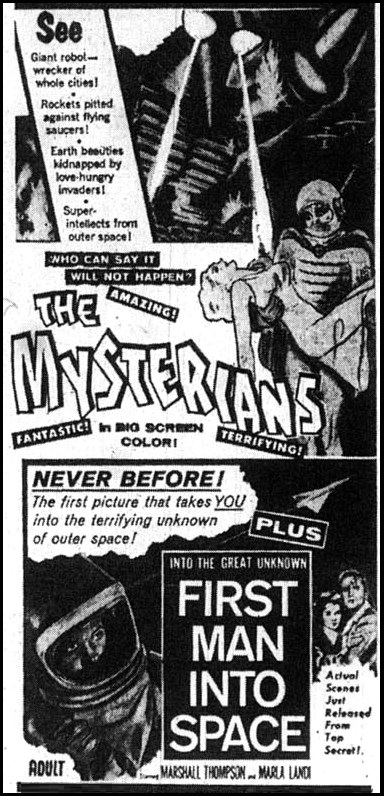
 |
|
|
|
|
|
|
|
|
|
|
|
|
|
|
|
|
|
 |
 |
 |
Posted: |
Aug 14, 2017 - 11:45 AM
|
|
|
|
By: |
Bob DiMucci
(Member)
|
In 1962, Nakajima was back in the Godzilla suit for the fan favorite KING KONG VS. GODZILLA. Originally, director Ishiro Honda had thought about using stop motion animation instead of men in costumes, but due to budgetary concerns those plans were scrapped. However, there are a couple of scenes where the technique is used: first in the fight with the giant octopus as it grabs one of the natives, and second in the second battle between Kong and Godzilla when Godzilla gives Kong a dropkick.
The film marked the first appearance of either beast in widescreen and color. Akira Ifukube scored the film. The 99-minute original Japanese version of the film was written as a satirical comedy with jabs taken at the media business. For the English language version, the film was reedited to 90 minutes, with most of the social satire removed and some additional scenes featuring Michael Keith, James Yagi, and Harry Holcombe interpolated into the proceedings.

|
|
|
|
|
|
|
|
|
 |
 |
 |
Posted: |
Aug 14, 2017 - 1:06 PM
|
|
|
|
By: |
Bob DiMucci
(Member)
|
Toho squared off two of its own monsters in 1964's GODZILLA VS. MOTHRA (alternately, MOTHRA VS. GODZILLA; GODZILLA AGAINST MOTHRA). Haruo Nakajima was, of course, back as Godzilla. When the sequence of Godzilla being firebombed was shot, during one of the takes the flaming liquid splashed up onto Godzilla's head. The fuel quickly burned away and the flames went out. Inside the suit, Nakajima was unaware of the accident, since the head of the suit is well above Nakajima's own head. Godzilla's head aflame became an unplanned bonus to the effects shot and it was included in the final cut.
In another scene, when Godzilla is wading in the water heading for Iwo Island, he is only shot from behind. This was due to the fact that Haruo Nakajima was actually wearing the suit from KING KONG VS. GODZILLA (1962) instead of the GODZILLA VS. MOTHRA suit. It had already been planned to use the suit from this film for the next film in the series, and in order to save wear and tear it was decided to use the older suit when the shot permitted.
Ishiro Honda directed the film, with Akira Ifukube providing the score.
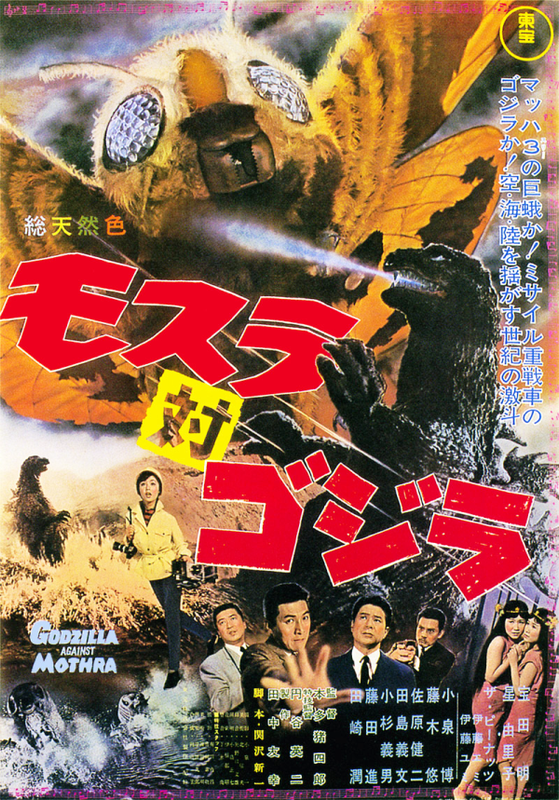
When American International Pictures acquired the film for U.S. distribution, the major change that was made was to the film's title. AIP re-titled the film GODZILLA VS. THE THING. Mothra's name is never used. Instead she is simply called "The Thing" in both the title and all dubbed English dialogue with the exception of the song sung by the twin fairies to summon and communicate with the monster.
Otherwise, although the film was shortened by 4 minutes from its Japanese running time, this was the first Godzilla film without newly-shot American footage added for the U.S. release. The scene in which Godzilla is attacked by the American military only exists in the American cut, but this footage was shot by Toho during the original Japanese shoot.
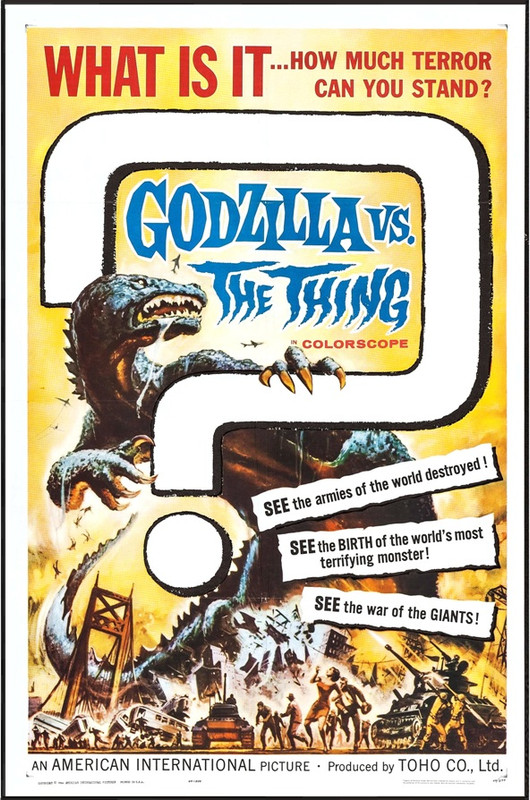
 |
|
|
|
|
|
 |
 |
 |
Posted: |
Aug 14, 2017 - 1:53 PM
|
|
|
|
By: |
Bob DiMucci
(Member)
|
The success of GODZILLA VS. MOTHRA caused Toho to quickly produce and release another monster showdown film in 1964. This time, Godzilla teamed with Mothra and Rodan to take on a new monster, King Ghidorah, which suitably had three heads to better deal with its three opponents. Ghidorah would later go on to be Toho's main villain monster, variously fighting both Godzilla and Mothra, as well as making appearances on Japanese television.
Prior to filming, however, the Godzilla suit needed to go through some repairs. During the filming of GODZILLA VS. MOTHRA, the mouth had become wobbly and would not work properly. The head had also caught on fire, which had damaged the suit. So the head of the suit was replaced by a more sturdy design. The new suit also had more mobility than the one it replaced. Ishiro Honda directed and Akira Ifukube scored the film.
When the film was picked up by the Walter Reade Organization for distribution in the U.S., the name of the new monster was shortened from "Ghidorah" to "Ghidrah." Shorn of 7 minutes of its Japanese running time,
GHIDRAH, THE THREE-HEADED MONSTER was released in the U.S. on 29 September 1965.
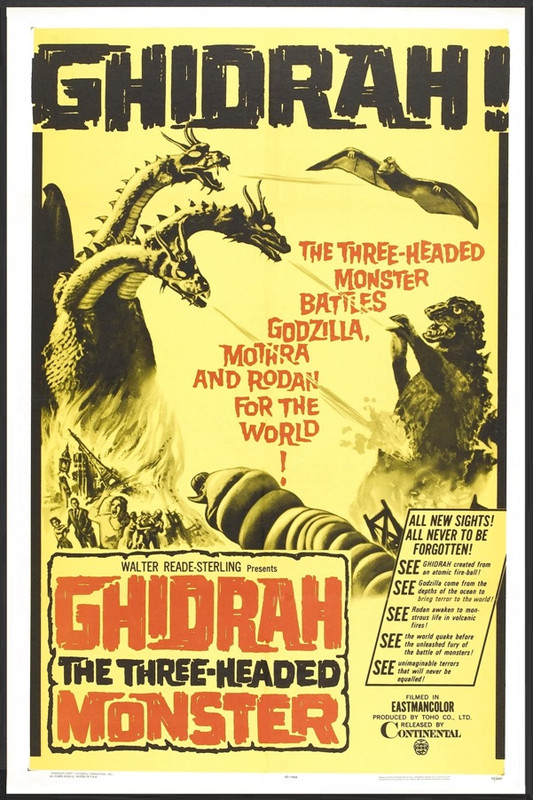
 |
|
|
|
|
|
|
|
 |
 |
 |
|
|
 |
 |
 |
| |
|
|
|
 |
|
 |
|
|
|


